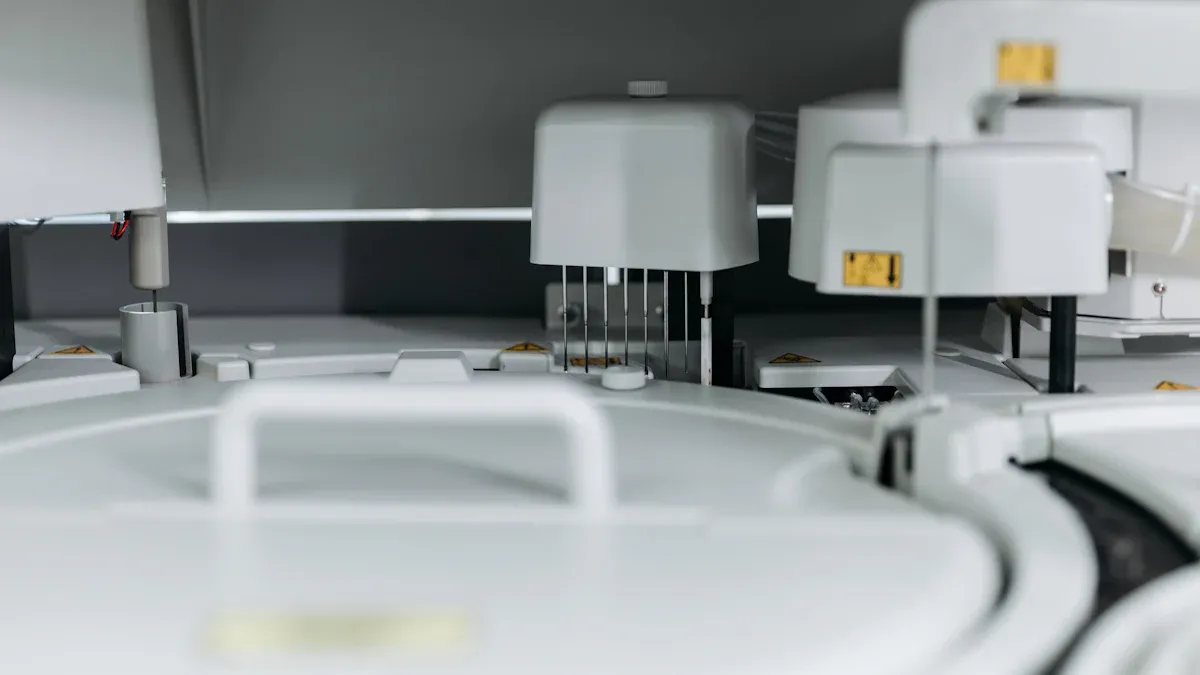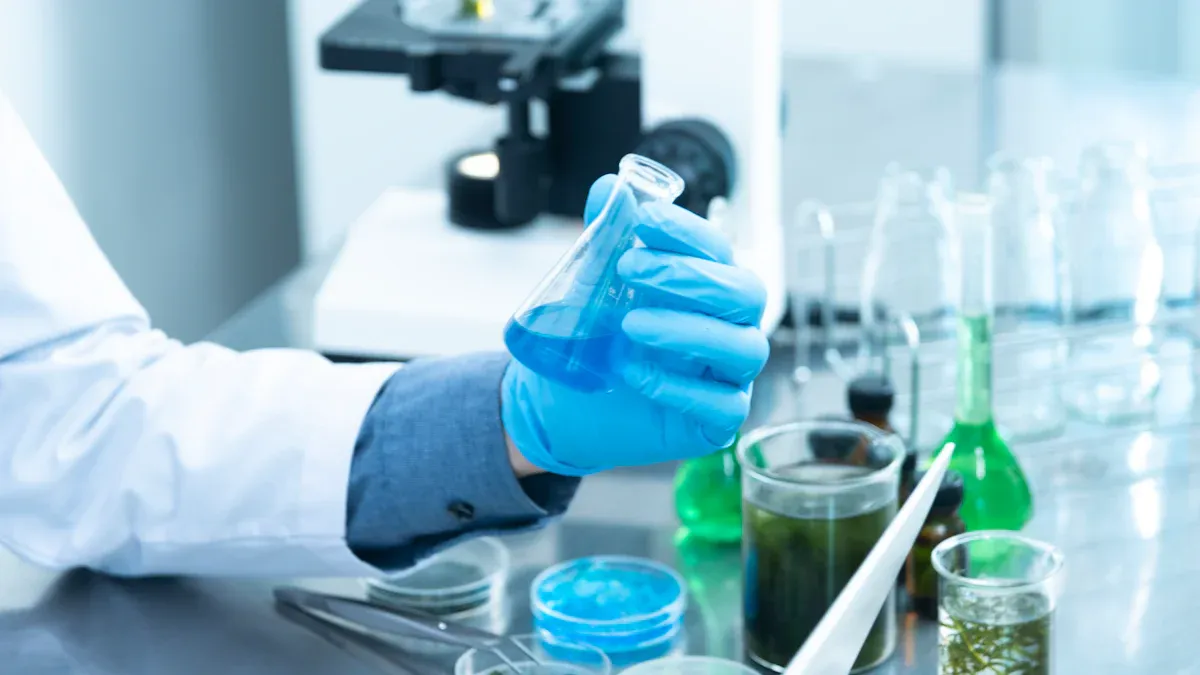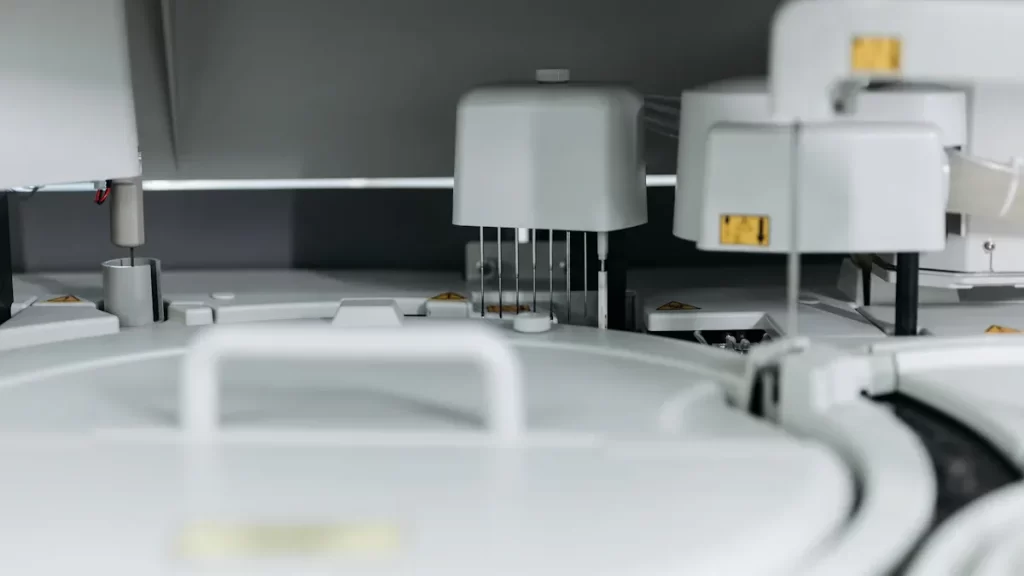News & Events
Streamlining Laboratory Processes with Plasmid Kits and ELISA in 2025

You can transform your lab workflow by integrating plasmid kits with ELISA immunoassays. This approach helps you produce recombinant proteins efficiently and generate antibodies quickly. You also lower the risk of contamination and support high-throughput screening. When you combine these methods, you get more reliable results and save valuable time.
Key Takeaways
- Integrating plasmid kits with ELISA speeds up lab workflows, allowing for faster results and reduced contamination risks.
- Using high-quality plasmid kits ensures reliable DNA preparation, which leads to more accurate ELISA results.
- Automation tools like liquid handlers enhance efficiency by minimizing human error and allowing for high-throughput sample processing.
- Optimizing growth conditions and selecting the right kits can significantly improve plasmid yields and assay sensitivity.
- Establishing clear zones for each workflow step helps prevent cross-contamination and maintains data integrity.
Plasmid Kits and ELISA Overview

Plasmid Kits in Research
You use plasmid kits to prepare and purify DNA for many experiments. These kits help you produce recombinant proteins and generate antibodies. In modern labs, plasmid kits give you a reliable way to create antigens and antibodies for elisa testing. You can trust the results because the kits reduce contamination and improve reproducibility.
Plasmid kits play a big role in drug research and patient safety. You can use them to make proteins that test drug efficacy. They help you avoid underdosing and prevent toxic side effects. You also get the chance to adjust treatments for each patient. Here are some main functions of plasmid kits in research:
- You ensure medications work as planned.
- You keep patients safe from harmful drug levels.
- You customize treatments for individual needs.
Plasmid kits make your workflow faster and more accurate. You spend less time on preparation and get consistent results every time.
ELISA Applications
You use elisa to measure proteins, peptides, and small molecules in your samples. The enzyme-linked immunosorbent assay gives you high sensitivity and detects even tiny amounts of substances. You rely on elisa for clinical and research work because it is simple, stable, and fast.
Elisa works well with plasmid kits. You can use proteins made from plasmid kits as antigens in elisa tests. This combination lets you analyze samples quickly and with high specificity. You get reproducible results, which helps you make good decisions in your research.
Here are some key benefits of elisa in your lab:
- You detect trace levels of drugs and proteins.
- You get consistent results for every test.
- You make decisions faster with rapid turnaround times.
You can use elisa for high-throughput screening. This means you test many samples at once and save time. Plasmid kits provide the antigens and antibodies you need for these tests. You get a streamlined process that supports both clinical and research goals.
Workflow Challenges

Separate Processes
You often face challenges when you use plasmid kits and ELISA as separate steps in your workflow. Each process needs its own space and equipment. You must avoid bringing concentrated plasmids into Pre-PCR or Reagent Rooms. You dilute plasmids in a designated area to prevent contamination. You wipe tube exteriors with bleach or DNA-Away® before entering sensitive spaces. These steps help you keep your samples clean, but they also slow down your work.
Tip: Set up clear zones for each process. This helps you avoid cross-contamination and keeps your workflow organized.
Bottlenecks
You may notice bottlenecks when you move samples between plasmid preparation and ELISA testing. Low DNA yield can happen if you do not grow enough bacteria or if cell lysis is incomplete. Poor DNA purity may result from protein or RNA contamination. DNA degradation can occur if you handle samples for too long or use degraded reagents. High viscosity of DNA can make pipetting difficult, especially with large plasmid constructs. Non-sterile techniques or contaminated reagents can lead to DNA contamination.
Here is a table showing common bottlenecks and their causes:
| Bottleneck | Cause |
|---|---|
| Low DNA Yield | Poor bacterial growth |
| Poor DNA Purity | Protein/RNA contamination |
| DNA Degradation | DNase or degraded reagents |
| High DNA Viscosity | Large constructs |
| DNA Contamination | Non-sterile techniques |
Data Quality Issues
You want reliable results from your workflow, but data quality issues can arise. If you do not purify DNA well, you may get false readings in ELISA tests. Protein or RNA contamination can interfere with your measurements. DNA degradation can lower the accuracy of your results. You must check your reagents and use proper techniques to keep your data trustworthy.
Note: Always check your DNA quality before starting ELISA. Good preparation leads to better results.
Integration Strategies
Combining Plasmid Kits and ELISA
You can create customized workflows by integrating plasmid kits with elisa protocols. This approach helps you move from plasmid isolation to elisa testing with fewer errors. You start by preparing your samples and controls on the day of the assay. You dilute serum or plasma in the right buffer. You block medium-binding elisa plates with BSA or goat serum buffer for one hour. You prepare standards using purified antibodies in serial dilutions. You add samples, controls, and standards to the elisa plates after washing and blocking.
- Prepare serum/plasma and control samples on the day of the assay. Dilute them in the correct buffer.
- Block elisa plates with BSA or goat serum buffer for one hour.
- Prepare standards using purified antibodies in serial dilutions.
- Wash and block the plates. Add samples, controls, and standards.
- Do not rock the plates during incubation. This step helps proper bond formation.
- Make sure the colony-forming units of precipitated phage are above 1 × 10^12 cfu/mL.
- Pre-block phages for at least 20 minutes before adding to the elisa plates.
You can use sandwich elisa, direct elisa, or indirect elisa depending on your needs. Sandwich elisa works well for detecting low-abundance proteins and improves assay sensitivity. Direct elisa gives you quick results for simple targets. Indirect elisa helps you measure antibody levels with high specificity. You can use cloning to produce the antigens needed for these tests. Molecular cloning lets you create proteins for sandwich elisa and indirect elisa. You get reliable results and improve assay sensitivity.
Tip: Always check your plasmid DNA quality before starting elisa. Good plasmid isolation leads to better results.
Automation in Sample Handling
You can boost productivity by using automation in your workflow. Robotic platforms pick colonies and inoculate plates for plasmid DNA preparations. Liquid handling devices automate pipetting and mixing for elisa assays. Automation systems integrate multiple instruments for high-throughput applications. You save time and reduce human error.
| Technology Type | Description | Applications in Workflows |
|---|---|---|
| Robotic Platforms | Designs for robotic stations that handle various lab operations, including picking colonies and inoculating plates. | Used for high-throughput sample handling in plasmid DNA preparations and elisa assays. |
| Liquid Handling Devices | Automated systems for precise liquid handling, integrated with other components for DNA and protein workflows. | Essential for plasmid DNA preparations, normalizations, and elisa-based assays. |
| Automation Systems | Systems designed for high-throughput applications, integrating multiple instruments for efficiency. | Facilitates the automation of complex workflows in integrated plasmid kit and elisa processes. |
You can use the Tecan EVO Liquid Handler to improve automation. This device helps with genomics, PCR preparation, nucleic acid extraction, and next-generation sequencing. You can use it for synthetic biology tasks like CRISPR, cloning, and plasmid preparation. It supports diagnostics, including elisa assays, biomarker detection, and pathogen detection. You can also use it for drug discovery, high-throughput screening, and enzymatic assays.
Note: Automation reduces mistakes and speeds up your workflow. You get more consistent results with automated nucleic acid extractions.
Nucleic Acid Purification Methods
You improve reproducibility and lower contamination by using nucleic acid purification methods. These methods remove unwanted substances from your plasmid DNA. Automation in purification processes minimizes human error. High-quality purification kits give you reliable results in downstream applications like elisa. Maxiprep kits provide large amounts of plasmid DNA with high purity. The purification process removes cellular debris and improves the quality of your plasmid DNA.
- Nucleic acid purification methods reduce contamination by removing unwanted substances.
- Automation in purification minimizes human error.
- High-quality purification kits improve reproducibility in elisa workflows.
- Maxiprep kits yield large quantities of pure plasmid DNA.
- The purification process removes cellular debris and boosts DNA quality.
You can use automated extraction systems to streamline nucleic acid purification. These systems help you get consistent results for sandwich elisa and indirect elisa. You can rely on integrated solutions to combine plasmid isolation, cloning, and elisa testing in one workflow. You get better assay sensitivity and reproducibility.
Tip: Use high-quality kits for nucleic acid purification. You get cleaner plasmid DNA and more accurate elisa results.
Workflow Example
Plasmid Extraction to ELISA
You can streamline your lab work by connecting plasmid extraction directly to ELISA testing. Start by isolating plasmid DNA from your bacterial cultures. Use a high-quality kit to get pure DNA. This step helps you avoid contamination and ensures your downstream results stay reliable. After you extract the DNA, you use it to express your target protein or antibody in mammalian cells. The ExpiFectamine™ 293 Transfection Kit lets you quickly produce antibodies. You can then collect these antibodies from the cell culture supernatant.
Next, you prepare your ELISA plates. Coat the plates with your antigen or antibody, depending on your assay design. Use standardized constructs to keep your ELISA results consistent. This approach gives you reliable sensitivity and performance, even when you test different antibody concentrations or coating densities. You add your samples, controls, and standards to the ELISA plate. After incubation and washing, you detect the signal that tells you how much antibody or antigen is present.
Tip: Always check the quality of your plasmid DNA before you start your ELISA. Good DNA leads to better antibody production and more accurate ELISA results.
High-Throughput Screening
You can boost your lab’s efficiency by using high-throughput screening with ELISA. Automated platforms like the Fluent 480 help you process many samples at once. These systems handle ELISA steps with precision and speed. You save time and reduce errors. The Munich Leukemia Laboratory uses integrated immunoassays in their workflow. This practice shows how automation and good lab techniques improve results.
With high-throughput ELISA, you can test hundreds of samples for antibody levels or antigen presence. You use plasmid DNA to make standardized controls for each run. This step ensures your ELISA stays accurate across many plates. Automation lets you track DNA, antibody, and ELISA data easily. You get fast answers and can make decisions quickly.
- Use automated liquid handlers for ELISA setup.
- Track DNA and antibody samples with software.
- Standardize controls with plasmid DNA for every ELISA run.
You can rely on this workflow to deliver consistent, high-quality results in your lab.
Benefits and Implementation
Speed and Accuracy
You can speed up your laboratory workflow by integrating plasmid kits with ELISA. When you use these tools together, you move from plasmid extraction to antibody production and detection in less time. You do not need to wait for separate steps or repeat tasks. This approach helps you get results faster and with fewer errors.
You can trust the accuracy of your detection because you use standardized antigen and antibody preparations. When you coat ELISA plates with antigens made from plasmid kits, you get a strong and clear signal. This signal detection helps you measure even small changes in antibody levels. You can spot low concentrations of antigen or antibody, which improves your sensitivity. You also reduce the risk of contamination, so your results stay reliable.
Tip: Use high-quality plasmid kits and ELISA plates to boost your detection accuracy and signal strength.
Reproducibility
You want your experiments to give the same results every time. Integrated workflows help you achieve this goal. When you use the same plasmid kit and ELISA protocol, you get consistent antigen and antibody preparations. This consistency leads to reproducible detection and signal results.
- PharmaTest ELISA Kits give you reproducible results for therapeutic drug monitoring.
- These kits detect trace levels of drugs, so you can adjust dosages with confidence.
- Studies by Sanchez-Hernandez et al. (2019) and Schmitz et al. (2016) show high sensitivity and reproducibility for these ELISA kits.
You can rely on these workflows for both research and clinical detection. When you use the same antigen and antibody sources, you reduce variation in your signal. This approach helps you compare results across different experiments and time points.
Resource Optimization
You can make the most of your lab resources by following a few simple strategies. Optimization starts with your raw materials. If you increase the amount of culture you process, you get higher plasmid yields. Make sure your kit can handle the extra biomass. Choose the right E. coli strain for plasmid propagation. Some strains give you better yields and more stable plasmids.
You also need to use the best growth conditions. Adjust the temperature, shaking speed, and culture medium to get the most out of your bacteria. These steps help you produce more antigen and antibody for your detection assays. When you optimize your workflow, you save time, reduce waste, and improve your signal detection.
- Process more culture to boost plasmid yield.
- Pick the best E. coli strain for your needs.
- Fine-tune growth conditions for better antigen and antibody production.
Note: Optimization helps you get stronger signals and more reliable detection in every ELISA run.
Kit and Equipment Selection
You need to choose the right kits and equipment for your workflow. Look for plasmid kits that match your sample size and purity needs. Some kits work better for high-throughput detection, while others focus on maximum yield. Pick ELISA kits that offer high sensitivity and clear signal detection. Make sure your kits support the antigens and antibodies you want to measure.
Automation tools can help you handle more samples and improve your efficiency. Liquid handlers and robotic platforms let you set up ELISA plates quickly and accurately. Use software that tracks your samples, antibody stocks, and detection results. This approach helps you avoid mix-ups and keeps your data organized.
| Selection Criteria | What to Look For | Why It Matters |
|---|---|---|
| Plasmid Kit Capacity | Fits your culture volume and yield needs | Ensures enough antigen/antibody for ELISA |
| ELISA Kit Sensitivity | Detects low levels of antigen or antibody | Improves detection and signal accuracy |
| Automation Compatibility | Works with liquid handlers and robots | Boosts efficiency and reduces errors |
| Software Integration | Tracks samples and detection data | Keeps workflow organized |
Callout: Always test new kits and equipment with your antigen and antibody samples before scaling up. This step ensures strong signal detection and reliable results.
You can transform your lab by integrating plasmid kits with ELISA immunoassays. This approach gives you faster results, better accuracy, and more reliable data. You also make your workflow easier to scale for larger projects.
Tip: Start using these strategies in your lab today. Explore trusted resources and keep learning to stay ahead in 2025.
FAQ
What is the main benefit of integrating plasmid kits with ELISA?
You get faster results and more reliable data. This integration helps you reduce contamination and improve reproducibility. You can test more samples in less time.
How do you prevent contamination during plasmid and ELISA workflows?
Always use separate work zones for each step. Clean tube exteriors with bleach or DNA-Away®. Use high-quality purification kits to keep your samples clean.
Which automation tools work best for high-throughput ELISA?
You can use the Tecan EVO Liquid Handler or Fluent 480. These devices help you process many samples quickly and reduce human error.
Can you use plasmid kits for both research and clinical testing?
| Application | Use Case Example |
|---|---|
| Research | Protein production |
| Clinical | Therapeutic drug monitoring |
You can use plasmid kits for both. They help you produce proteins for research and monitor drugs in clinical labs.

